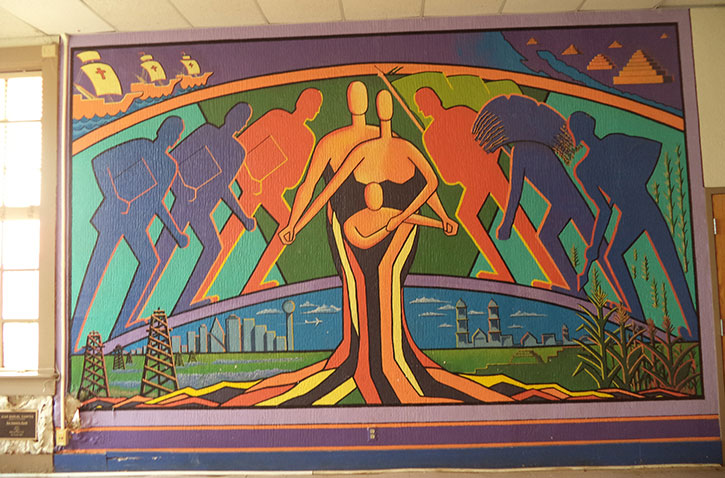Meadows Collaborates on Pike Park Exhibit at Latino Cultural Center, Opening September 12
"Uptown’s Pike Park: Little Jerusalem to Little Mexico, 100 Years of Settlement" explores the Dallas immigrant experience

Sandwiched between the skyscrapers on the west side of downtown Dallas is a green space called Pike Park, home to 100 years of Dallas history. Alternately known over the years as “Little Jerusalem” and “Little Mexico,” the four-and-a-half-acre park has served as a gathering spot for immigrant families since 1914.
With the help of members of the Meadows School of the Arts community, three local organizations are presenting a Pike Park exhibit that traces the roots of Jewish and Mexican immigrants in Dallas. “Uptown’s Pike Park: Little Jerusalem to Little Mexico, 100 Years of Settlement” will be at the Latino Cultural Center, 2600 Live Oak Street, September 12 – October 18, 2014, and is presented by the Dallas Mexican American Historical League, the Dallas Jewish Historical Society and the Latino Cultural Center.
Two members of the Meadows community made curatorial contributions to the exhibit. Associate Professor of Art History Janis Bergman-Carton served on the exhibition committee and collaborated with the City of Dallas archivist and the director of Parks and Recreation. She conducted research, wrote text for the exhibit panels and will serve as a speaker and moderator during programs to be held at the Latino Cultural Center. She also arranged for Meadows graduate student Lucy Anderton McGuigan (M.A. Art History ’16) to work on the exhibit.
In addition to doing curatorial research, McGuigan edited vintage photographs and graphic illustrations and designed the exhibit’s narrative text panels and labels.
“This project reminds us how easily the diverse cultural history of a city like Dallas can get lost in the unintended consequences of urban redevelopment,” says Bergman-Carton. “The exhibition tells the story of Pike Park’s importance in Dallas history and its resilience, despite the displacement of the communities it was built to serve and periodic threats of closure.”
The public is invited to the exhibit’s grand opening reception on Thursday evening, September 18, 6:00-8:00 p.m. and can make reservations here.
About Pike Park
Many don’t realize that the area surrounding Pike Park was initially settled in the late 1800s by poor Eastern European Jewish immigrants and was alternately referred to as Little Jerusalem, Goose Valley or Frogtown. With a solid sense of commitment to one another and strong family ties, the Jewish settlers became established. The area flourished with entrepreneurial businesses, schools, and synagogues and the park was in the heart of the Jewish community.
From 1910 to1930 the Mexican community in Dallas grew rapidly due to displacement during the Mexican Revolution and job opportunities stimulated by the railroads and the city’s industrialization. During the same period the rising middle class Jewish community began moving out of old North Dallas to South Dallas, and Little Jerusalem began its transition to Little Mexico. Albert Valtierra, president of the Dallas Mexican American Historical League, says, “The early Mexican settlers, then referred to as colonists, followed a similar settlement pattern in developing the area. Neighborhoods, businesses, schools and churches thrived.”
Pike Park, originally named Summit Play Park, was developed in 1914. Located on Turney Avenue (now Harry Hines), the four and a half acres were purchased by the City of Dallas for $18,085. Though it was in a congested area of the old Second Ward at the time, it was considered a state-of-the-art park. Debra Polsky, executive director for the Dallas Jewish Historical Society and exhibit co-chair, says, “This city project was the first in Dallas to look at the recreational needs of an established neighborhood and design a park to meet those needs—as plan architect George Kessler intended.” The magnificent field house, which cost $25,000, contained shower baths, reading rooms, an assembly hall, and every convenience for all ages. Outdoor amenities included a wading pool, tennis courts, outdoor playground equipment and baseball fields. In 1927, the park was renamed Pike Park in honor of Edgar L. Pike, a former and longtime member of the Dallas City Park Board who contributed to the broader development of the Dallas park system. Mr. Pike was married to Jessica Sanger, daughter of Philip Sanger.
For more information, contact the Dallas Jewish Historical Society at 214-239-7120 or Dallas Mexican American Historical League at 214-236-7673.